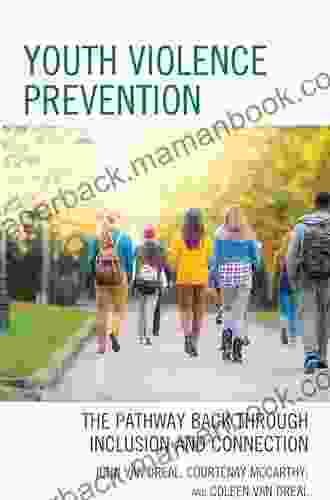The Pathway Back Through Inclusion and Connection: A Comprehensive Guide to Rebuilding Belonging and Meaning

In today's rapidly changing and increasingly complex world, the importance of inclusion and connection has become more apparent than ever before. Feeling connected to others and having a sense of belonging are essential for our mental, physical, and emotional well-being. When we feel included and connected, we are more likely to be happy, healthy, and successful in all aspects of our lives.
5 out of 5
| Language | : | English |
| File size | : | 1024 KB |
| Text-to-Speech | : | Enabled |
| Screen Reader | : | Supported |
| Enhanced typesetting | : | Enabled |
| Word Wise | : | Enabled |
| Print length | : | 186 pages |
Unfortunately, many people experience social isolation and loneliness, which can lead to a variety of negative consequences. Social isolation is defined as the lack of social connections with others, while loneliness is a subjective feeling of being alone and disconnected from the world. Both social isolation and loneliness have been linked to increased risk of depression, anxiety, heart disease, stroke, and even death.
The good news is that there are many things we can do to promote inclusion and connection and reduce social isolation and loneliness. This article will provide a comprehensive guide to understanding the barriers to inclusion, the benefits of fostering a sense of belonging, and practical strategies for creating inclusive and connected environments.
Barriers to Inclusion
There are a number of factors that can contribute to social isolation and loneliness, including:
- Age: Older adults are more likely to experience social isolation and loneliness, due to factors such as retirement, loss of loved ones, and decreased mobility.
- Disability: People with disabilities may face barriers to social participation, such as inaccessible transportation, lack of adaptive equipment, and negative attitudes from others.
- Race and ethnicity: People of color are more likely to experience social isolation and loneliness, due to factors such as racism, discrimination, and segregation.
- Sexual orientation and gender identity: LGBTQ+ people are more likely to experience social isolation and loneliness, due to factors such as homophobia, transphobia, and discrimination.
- Poverty: People who live in poverty are more likely to experience social isolation and loneliness, due to factors such as lack of access to resources, transportation, and social networks.
- Mental illness: People with mental illness are more likely to experience social isolation and loneliness, due to factors such as stigma, discrimination, and difficulty maintaining relationships.
- Substance use: People who use substances are more likely to experience social isolation and loneliness, due to factors such as loss of relationships, social stigma, and legal problems.
The Benefits of Inclusion
Fostering a sense of inclusion and connection has numerous benefits for individuals and communities, including:
- Improved mental health: Inclusion and connection can reduce symptoms of depression, anxiety, and loneliness, and promote overall well-being.
- Improved physical health: Inclusion and connection can strengthen the immune system, reduce inflammation, and improve heart health.
- Increased social support: Inclusion and connection can provide access to social support, which can help people cope with stress, solve problems, and achieve their goals.
- Increased sense of belonging: Inclusion and connection can create a sense of belonging, which can lead to greater self-esteem and a more positive outlook on life.
- Increased civic engagement: Inclusion and connection can encourage people to participate in their communities and make a difference in the world.
Strategies for Creating Inclusive and Connected Environments
There are many things we can do to create more inclusive and connected environments, both at home and in our communities. Here are a few ideas:
- Be intentional about creating opportunities for connection. Make an effort to reach out to others, especially those who may be feeling isolated or marginalized. Invite people to join you for activities, or simply make a point of saying hello and chatting with people you see regularly.
- Be inclusive in your language and actions. Use inclusive language that respects the diversity of others, and avoid making assumptions about people based on their appearance or background. Be mindful of your body language and nonverbal cues, and make sure they convey warmth and openness.
- Create safe and welcoming spaces. For both physical and virtual spaces, make sure they are free of discrimination and harassment, and that everyone feels comfortable and respected.
- Provide opportunities for people to share their voices and perspectives. Create opportunities for people to share their stories, experiences, and ideas. This can help to build understanding and empathy, and create a more inclusive and connected community.
- Support organizations and initiatives that promote inclusion and connection. There are many organizations and initiatives working to promote inclusion and connection in our communities. Find ways to support their work, either through donations, volunteering, or advocacy.
Inclusion and connection are essential for our well-being and happiness. By understanding the barriers to inclusion, the benefits of fostering a sense of belonging, and practical strategies for creating inclusive and connected environments, we can create a more just and equitable society for all.
The path back through inclusion and connection is not always easy, but it is essential. By working together, we can create a world where everyone feels connected, valued, and supported.
5 out of 5
| Language | : | English |
| File size | : | 1024 KB |
| Text-to-Speech | : | Enabled |
| Screen Reader | : | Supported |
| Enhanced typesetting | : | Enabled |
| Word Wise | : | Enabled |
| Print length | : | 186 pages |
Do you want to contribute by writing guest posts on this blog?
Please contact us and send us a resume of previous articles that you have written.
 Top Book
Top Book Novel
Novel Fiction
Fiction Nonfiction
Nonfiction Literature
Literature Paperback
Paperback Hardcover
Hardcover E-book
E-book Audiobook
Audiobook Bestseller
Bestseller Classic
Classic Mystery
Mystery Thriller
Thriller Romance
Romance Fantasy
Fantasy Science Fiction
Science Fiction Biography
Biography Memoir
Memoir Autobiography
Autobiography Poetry
Poetry Drama
Drama Historical Fiction
Historical Fiction Self-help
Self-help Young Adult
Young Adult Childrens Books
Childrens Books Graphic Novel
Graphic Novel Anthology
Anthology Series
Series Encyclopedia
Encyclopedia Reference
Reference Guidebook
Guidebook Textbook
Textbook Workbook
Workbook Journal
Journal Diary
Diary Manuscript
Manuscript Folio
Folio Pulp Fiction
Pulp Fiction Short Stories
Short Stories Fairy Tales
Fairy Tales Fables
Fables Mythology
Mythology Philosophy
Philosophy Religion
Religion Spirituality
Spirituality Essays
Essays Critique
Critique Commentary
Commentary Glossary
Glossary Bibliography
Bibliography Index
Index Table of Contents
Table of Contents Preface
Preface Introduction
Introduction Foreword
Foreword Afterword
Afterword Appendices
Appendices Annotations
Annotations Footnotes
Footnotes Epilogue
Epilogue Prologue
Prologue Nick Duffell
Nick Duffell Henry William Herbert
Henry William Herbert Johnny Ray
Johnny Ray Julia Cameron
Julia Cameron Jake Adelstein
Jake Adelstein Dana Thomas
Dana Thomas Rachel Louise Snyder
Rachel Louise Snyder Thomas W Phelan
Thomas W Phelan Norm Foster
Norm Foster Julie Clark
Julie Clark Richard D Parsons
Richard D Parsons Maxim Dsouza
Maxim Dsouza Jean Marc Martin
Jean Marc Martin Kristen Carter
Kristen Carter Emily Juniper
Emily Juniper Jennifer D Klein
Jennifer D Klein Vincent Barletta
Vincent Barletta Tom Spence
Tom Spence Stephanie Brother
Stephanie Brother Kate Elizabeth Russell
Kate Elizabeth Russell
Light bulbAdvertise smarter! Our strategic ad space ensures maximum exposure. Reserve your spot today!

 Reed MitchellHer Take on Real Love and Healthy Relationships: A Candid Conversation with...
Reed MitchellHer Take on Real Love and Healthy Relationships: A Candid Conversation with... Roy BellFollow ·19.8k
Roy BellFollow ·19.8k Kenzaburō ŌeFollow ·4.3k
Kenzaburō ŌeFollow ·4.3k Bernard PowellFollow ·15.1k
Bernard PowellFollow ·15.1k Nikolai GogolFollow ·9.1k
Nikolai GogolFollow ·9.1k Ronald SimmonsFollow ·18.4k
Ronald SimmonsFollow ·18.4k Norman ButlerFollow ·8.6k
Norman ButlerFollow ·8.6k Carl WalkerFollow ·6.5k
Carl WalkerFollow ·6.5k Doug PriceFollow ·17.8k
Doug PriceFollow ·17.8k

 Jeremy Mitchell
Jeremy MitchellPlay We Now On Christmas Violin Christmas: A Heartfelt...
Play We Now On...

 Terry Bell
Terry BellTales from the Road: Confessions of an Atlanta Uber...
In the vibrant...

 Ervin Bell
Ervin BellThe French Admiral: A Gripping Naval Adventure with Alan...
In the vast expanse of...

 Henry David Thoreau
Henry David ThoreauCrochet Cozy Afghan Patterns: Crochet Weekend Afghan...
to Crochet...

 Orson Scott Card
Orson Scott CardAn Archaeological View Of The Industrialization Of North...
The industrialization of North America was a...

 Josh Carter
Josh CarterClipboard Christmas Skits by Tom Spence: A Festive...
A Christmas...
5 out of 5
| Language | : | English |
| File size | : | 1024 KB |
| Text-to-Speech | : | Enabled |
| Screen Reader | : | Supported |
| Enhanced typesetting | : | Enabled |
| Word Wise | : | Enabled |
| Print length | : | 186 pages |










